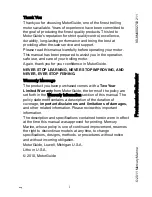
Distributor of Microchip Technology: Excellent Integrated System Limited
Datasheet of TDGL004 - BOARD CEREBOT 32MX7 PIC32MX795
Contact us: [email protected] Website: www.integrated-circuit.com
Cerebot 32MX7 Reference Manual
www.digilentinc.com
page 5 of 19
Copyright Digilent, Inc. All rights reserved. Other product and company names mentioned may be trademarks of their respective owners.
microcontroller, so a USB PLL input divider
value of 2 must be used. These parameters
are set in the PIC32 microcontroller
configuration registers using the
#pragma
config
statement. The following statements
must be used to configure the PIC32
microcontroller for use of the USB controller:
#pragma config UPLLEN = ON
#pragma config UPLLIDIV = DIV_2
When operating as a USB device, the Cerebot
32MX7 can be used as a self powered device
or as a bus powered device. To operate as a
self powered device, an external power supply
should be connected to one of the external
power connectors (J17 or J18) and a shorting
block placed on the center, “EXT” position of
J16. The external power supply must be a
regulated 5V supply. To operate as a bus
powered device, the shorting block should be
placed in the USB Device position, “USB”, on
J16.
Connector J19, on the bottom of the board in
the lower right corner is the Device/OTG
connector. This is a standard USB micro-AB
connector. Connect a cable with a micro-A
plug (optionally available from Digilent) from
this connector to an available USB port on a
PC or USB hub for device operation.
When operating as a USB host, the Cerebot
32MX7 must be externally powered. Connect
a regulated 5V power supply to one of the
external power connectors (J17, or J18) and
ensure that the shorting block is in the center,
“EXT” position of J16. The power supply used
must be a regulated 5V supply. The Cerebot
32MX7 board provides power to the attached
USB device when operating as a host, and the
USB specification requires the use of a 5V
power supply. NOTE: Providing a voltage
greater than 5V can damage the Cerebot
32MX7 board and/or the USB device being
used.
Jumper JP10 is used to route power to the
host connector being used. Place the shorting
block in the “A” position when using the
standard USB type A (host) Connector, J20.
Place the shorting block in the “MICRO”
position for use with the USB micro-AB (OTG)
connector, J19.
When operating as a USB host, the
PIC32MX795 microcontroller controls
application of power to the connected device
via the VBUSON control pin (labeled
P32_VBUSON in the schematic). Bus power
is applied to the device by driving the VBUSON
pin high. Power is removed from the device by
driving the VBUSON pin low. The VBUSON
pin is accessed via bit 3 of the U1OTGCON
register.
The VBUSON pin drives the enable input of a
TPS2051B Current-Limited Power Distribution
Switch to control the application of USB power
to the host connector. This switch has over-
current detection capability and provides an
over-current fault indication by pulling the
signal P32_USBOC low. The over-current
output pin can be monitored via the INT1/RE8
pin on the PIC32MX795 microcontroller.
Details about the operation of the TPS2051B
can be obtained from the data sheet available
at the Texas Instruments web site.
There are reference designs available on the
Microchip web site demonstrating both device
and host operation of PIC32 microcontrollers.
These reference designs are suitable to use for
developing USB firmware for the Cerebot
32MX7 board.
Ethernet Interface
The Cerebot 32MX7 provides the ability to
interface with 10Mbps or 100Mbps Ethernet
networks. The PIC32MX795 microcontroller
contains a 10/100 Ethernet Medium Access
Controller (MAC). External to the
microcontroller, the Cerebot 32MX7 board
provides an SMSC LAN8720 Ethernet Physical
Layer Transceiver (PHY). Together, the MAC
and PHY in combination with an appropriate
coupling transformer and RJ45 jack provide a
standard 10/100 Ethernet interface.
6 / 20
6 / 20






































